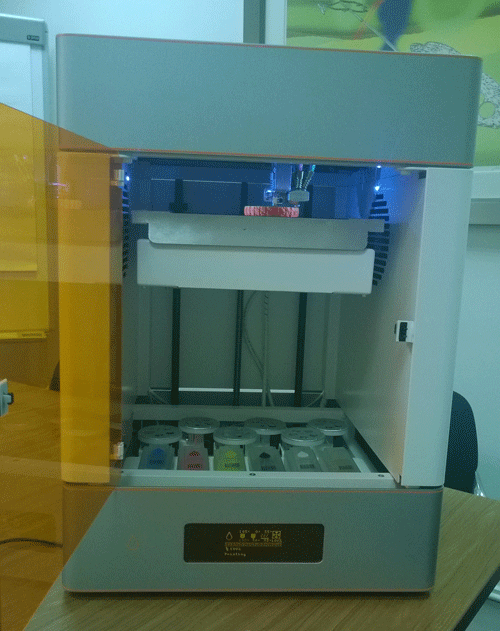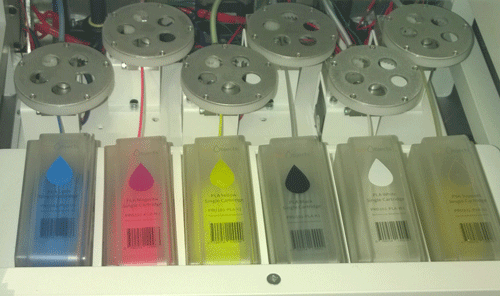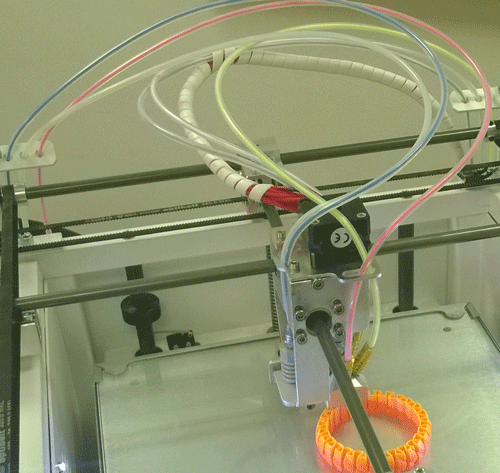Original URL: https://www.theregister.com/2014/05/29/3d_printer_does_colour/
ProDesk colour 3D printer's secret: It gives hot models great head
Squirting nozzle performs in five-way session for Reg hack
Posted in Personal Tech, 29th May 2014 08:02 GMT
Hands on The botObjects ProDesk3D isn’t the world's first full-colour 3D printer – but at £3,299, it’s substantially the cheapest. As a fused deposition modelling printer, it uses six cartridges to output a full spectrum of colours.
The development of 3D printers today is akin to the heady days of microcomputers in the early 1980s, with big companies like 3D Systems and Stratasys playing the roles of DEC and IBM – and small innovative startups like Formlabs and Makerbot playing Apple and Exidy.
You can now add London-based botObjects to the cast. And just like the infamous “28 days for delivery” promises of computer gear in the Eighties, the ProDesk3D printer has not had an easy birth: it was unveiled in April last year, and took on pre-orders around that time, but only now has it started shipping.
The machine looks more like a higher-end Formlabs printer than the vast majority of 3D-outputting devices. It is fully enclosed in tinted glass and aluminium; if you told a person in the 1960s to imagine something from the year 2000, this printer would be pretty close.
It has a raised, evenly heated platform – a 4mm layer of glass on a 4mm base of aluminium – on which models are gradually built. BotObjects boss Mike Duma told your humble hack that the startup worked very hard to find the right kind of glass: the model must adhere to the surface and yet must be possible to remove.

Behold, the guts of the ProDesk3D ... The build platform is raised, with the colour filaments below
It doesn’t need any Kapton tape to fix up things: models stick well to the ProDesk3D's build platform, and the 3D-printed gumble is easy to take off when the glass surface cools.
The heat is managed by fans which, much like a desktop PC cooler, suck air through the machine. Maintaining an even temperature is important as models can crack and come unstuck with drafts, as I found out with my own 3D printing experiments. The three fans should help the device maintain an even temperature.
Underneath the build platform is a protective plate, and below that the six spools for the filament held in cartridges. These are in the three traditional colours of yellow, magenta and cyan, plus black and white. The black is more a mid-grey as the addition of the other colours makes it black. The sixth cartridge is for support material. This is water soluble and provides a material to build on for shapes where there is an overhang. The cartridges were prototyped using a 3D printer.

Colour me pink, no, turquoise, argh ... the cartridges of filament
A spool and his money are soon parted
What makes the botObjects printer special is the print head. The five coloured filaments are driven by wheels in the base of the printer through feed tubes to the print head where they are melted and mixed. This technique sets it apart from most fused-deposition modelling printers, which use an extruder to pull through the filament – and radically different to other printers that use individual heads to print each colour so you can’t mix and generate shades.

Tip in point ... Five colours all meet in a single head to output the thing on the glass platform
The support material is extruded through a separate print head, and dissolves in warm water in about 20 minutes – so there is a little finishing required once the model is printed, but it is straightforward. There is no need to trim anything with a scalpel.
The printer’s firmware calculates the rate at which the different colours must be pushed to the print head in order to create the desired colour.
Duma claimed his printer rapidly switch between colours by purging the head either inside the shape – where the colour change will not be seen – or by dumping unwanted mixes at the edge of the build platform. All the demonstration pieces show gentle colour changes, however.
The ProDesk3D has a decent build volume of 275 x 275 x 300 mm and print speed of up to 175mm per sec.
One issue with printing in 3D is that the STL file format used by devices doesn’t have a protocol for assigning colour. BotObjects counters this by using its own header information. A file created in its own application can be imported into other tools and manipulated there without disturbing the header, and then written back with the colour information intact.
Filament pricing is on a par with high-quality non-colour printer filament; a complete object costs pennies to produce, whereas small objects built by colour machines from Stratasys can cost tens or hundreds of pounds.
Like Stratasys, botObjects is looking at new materials with a view to producing objects using malleable and translucent materials.
The first laser printers cost about £10,000 and then the first colour laser printers a similar amount. The first colour 3D printers from Stratsys will cost you well over £100,000. The ProDesk3D is about twice the price of a similarly specced mono 3D printer which makes it something of a bargain.
We’d like to see some users popping up on the 3D-printer owner forums to independently verify that shipments have started, and provide some examples of rapid colour changes.
The ProDesk3D could be a game-changer in the evolution of the desktop 3D printer, if the device lives up to its promise. ®